Part of a series of articles titled Volcano Types.
Previous: Cinder Cones
Next: Shield Volcanoes
Article

Image courtesy of AVO/USGS. McGimsey, R. G.
Composite volcanoes can be the most picturesque of all volcanoes. A classic composite volcano is conical with a concave shape that is steeper near the top. These mountains commonly have snow-covered peaks standing high above the surrounding mountainous terrain.
Composite cones are large volcanoes (many thousands of feet or meters tall) generally composed of lava flows, pyroclastic deposits, and mudflow (lahar) deposits, as well as lava domes. Composite volcanoes are active over long periods (tens to hundreds of thousands of years), and erupt periodically.
Composite volcanoes are also called stratovolcanoes. Some geologists avoid the use of the term “stratovolcano” because these volcanoes typically are not stratified and do not consist of orderly layers of lava flows and pyroclastic deposits.
At least eight units of the National Park System contain composite volcanoes, including.
Mount Rainier is an active volcano and the tallest peak in the Pacific Northwest. It is also considered to be the most dangerous volcano in the Lower 48, with destructive lahars being the greatest geologic hazard.
Brokeoff Volcano (Mount Tehama) in Lassen Volcanic National Park is a deeply eroded large composite volcano. It consisted of lava domes, lava flows, and pyroclastic deposits that are between 590,000 and 385,000 years old.
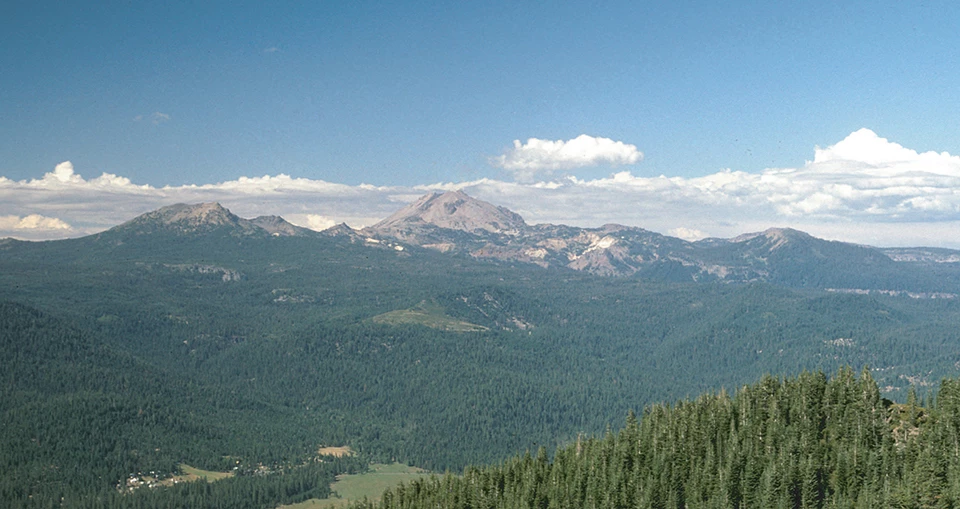
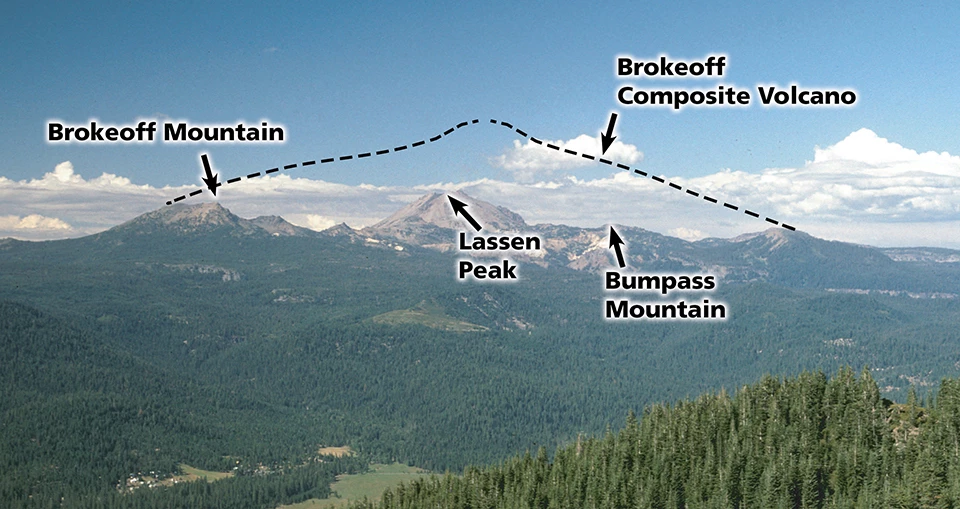
Left image
Brokeoff Volcano (Mount Tehama) in Lassen Volcanic National Park, California.
Credit: US Geological Survey photograph by Michael A. Clynne.
Right image
Projected profile of Brokeoff Volcano which would have risen to an elevation of 11,000 ft (3,300 m).
Credit: US Geological Survey photograph by Michael A. Clynne.
Redoubt Volcano and Iliamna Volcano are active composite volcanoes in Lake Clark National Park.
Katmai National Park contains several composite volcanoes, eight of which are active. The most recent eruptions in Katmai were from Trident Volcano between 1953 and 1974.
Vent Mountain and Half Cone are composite volcanoes that formed within Aniakchak Caldera in Aniakchak National Monument following the caldera-forming eruption occurred 3,700 years ago.
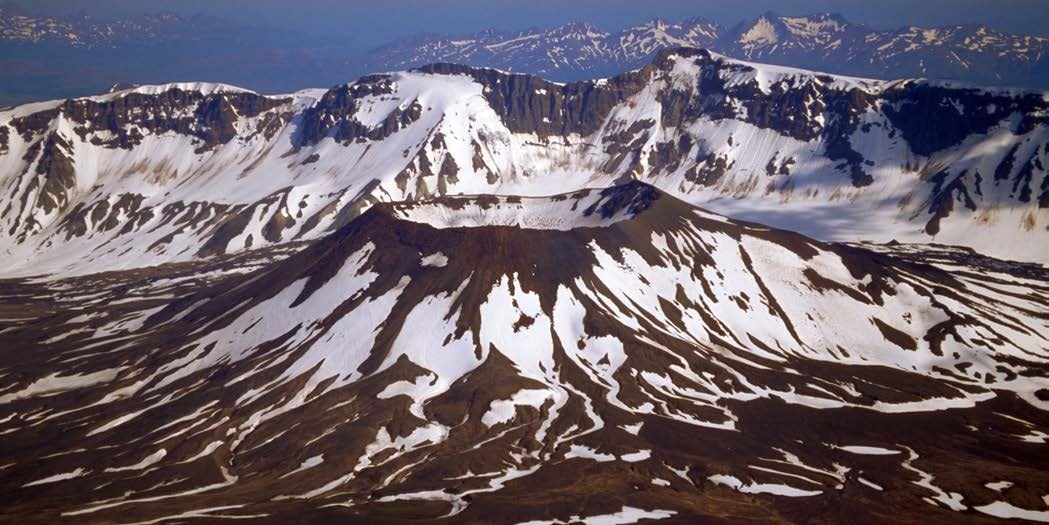
USGS photo by Game McGimsey.


Left image
Schematic diagram of a composite volcano.
Credit: Modified from USGS illustration.
Right image
Diagram with feature labels.
Credit: Modified from USGS illustration.
Composite volcanoes are probably the most complex type of volcanic edifice as they experience multiple eruptions, erupt lavas with a range of compositions, and experience many different types of eruptions. They may have multiple vents, but most composite cones have a main vent at the summit. Active composite volcanoes usually have a shallow magma chamber at depths of 3-6 miles (5-10 km).
Composite volcanoes are built up by successive eruptions of domes, lava flows and pyroclastic flows, but also can experience large blasts that destroy large areas of their summits, such as the May 1980 explosion and landslide at Mount St. Helens. Landslides may occur during eruptions or at other times.
Like all mountains, composite volcanoes are also subject to the forces of erosion that will ultimately erode them away. Areas of hydrothermally-altered rocks and poorly-consolidated pyroclastic deposits make them particularly susceptible to mass wasting events, including landslides, rock avalanches, lahars, and debris flows.
Composite volcanoes usually erupt a range of compositions from basalt to rhyolite, but intermediate (andesitic) and dacitic magmas are most common.
Mount Rainier has less compositional diversity than many composite cones as it consists of mostly andesitic lava flows and lahar deposits.
Composite cones experience many eruptions, as well as many different types of eruptions, during their history and evolution.
Eruptions may be phreatic, phreatomagmatic, and magmatic. Phreatic and phreatomagmatic eruptions are especially common on snow-covered or glaciated peaks. These steam eruptions may be precursors to later magmatic eruptions.
Magmatic eruptions range from effusive to extremely explosive (Paroxysmal) and reach up to 5 on the Volcanic Explosivity Index (VEI). Vulcanian, Sub-Plinean, and Plinean eruptions are typical for composite volcanoes.
Larger caldera-forming eruptions may occur at composite volcanoes and lead to their demise, such as the eruption of Mount Mazama 7,700 years ago that formed the caldera that has since filled with water to become Crater Lake.
Stratovolcanoes are polygenetic and are typically active over a period of hundreds of thousands years or longer, with multiple eruptions and intervening dormant periods in between.
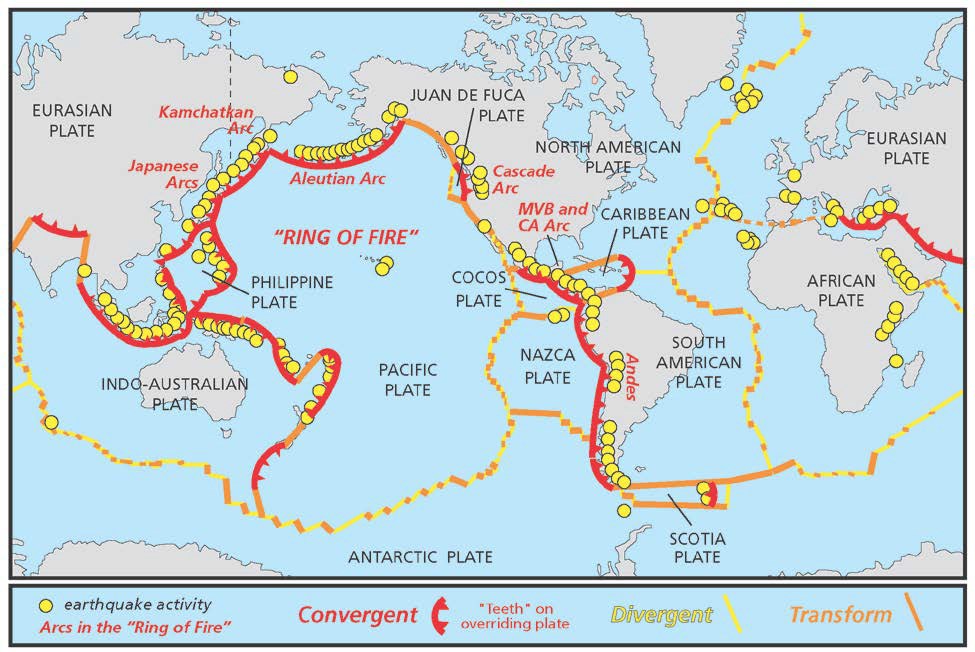
Composite volcanoes, like those found along the Pacific “Ring of Fire,” are usually found above subduction zones.
The volcanoes in the High Cascade Mountains of Washington, Oregon, and California formed from the subduction of the Juan de Fuca plate underneath the North American plate. Mount Rainier in Washington is one of several active composite volcanoes in this range that also includes Mount St. Helens.
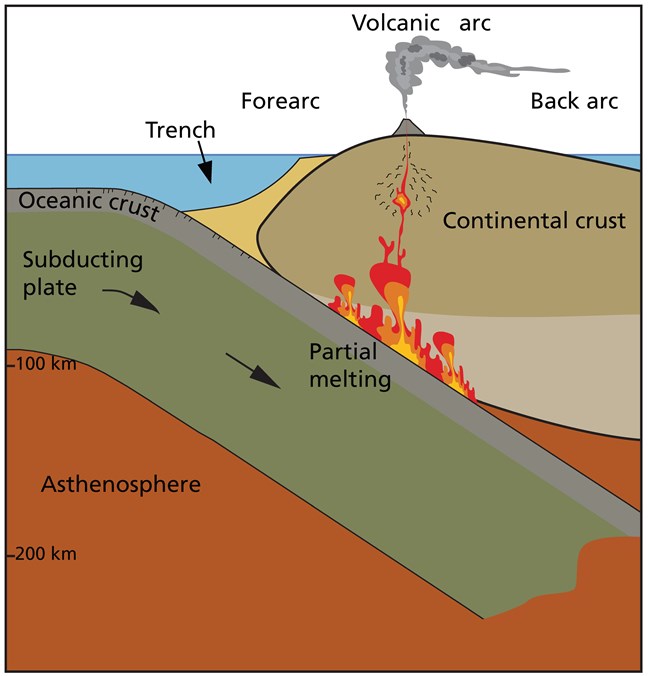
Subduction of the Pacific plate underneath the North American plate along the Alaska Peninsula and Aleutian Islands has produced the greatest concentration of active composite volcanoes in North America. Lake Clark National Park and Katmai National Park contain composite volcanoes that have experienced historic eruptions.
Image (right): Subduction zone showing partial melting caused by the descending plate. Chains of composite volcanoes are located parallel to the subduction zone.
Source: Modified from original graphic provided by Trista Thornberry- Ehrlich (Colorado State University).
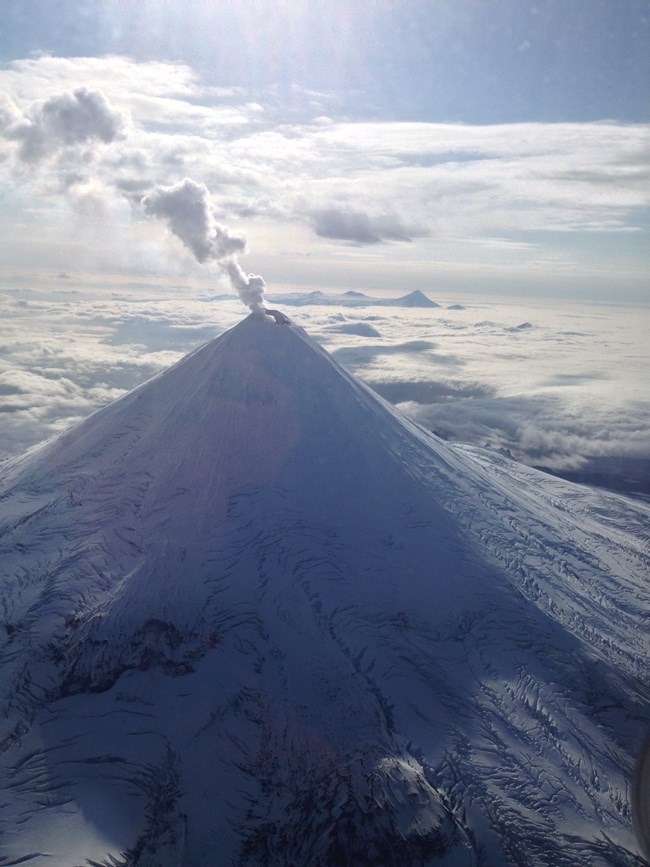
Image courtesy of Joseph Korpiewski and the US Coast Guard.
A crater is often located at the main vent area at the summit of an active composite volcano. These craters are typically blasted out by explosive eruptions.
Summit craters may contain fumaroles, and/or crater lakes, or be filled by glacial ice. The crater’s wall rock is commonly hydrothermally altered. Summit craters may also contain lava domes, such as the dome that grew during the 2009 eruption of Redoubt in Lake Clark National Park.
The summit crater of Mount Rainier is filled by glacial ice that is pocketed by ice caves due to melting caused by active fumaroles.
The location of the main vent may change through time, leading to complex or compound volcanoes such as Trident in Katmai National Park.
Composite volcanoes commonly also have subsidiary vents on their flanks. Cinder cones, maars or tuff rings, or domes may form at these lateral vents.
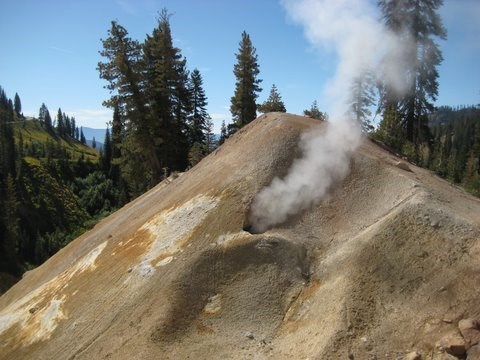
NPS photo.
Fumaroles are vents from which gases and vapors are emitted. They occur where shallow magma or hot volcanic deposits release gases, or where groundwater or melted glacial ice is heated to create steam. Fumaroles are common on active composite volcanoes, especially near the summit and near other vents.
Active fumaroles are present near the summit of Mount Rainier, and at several composite volcanoes in Katmai National Park and Preserve including Trident Volcano, Mount Griggs, and Fourpeaked Volcano.
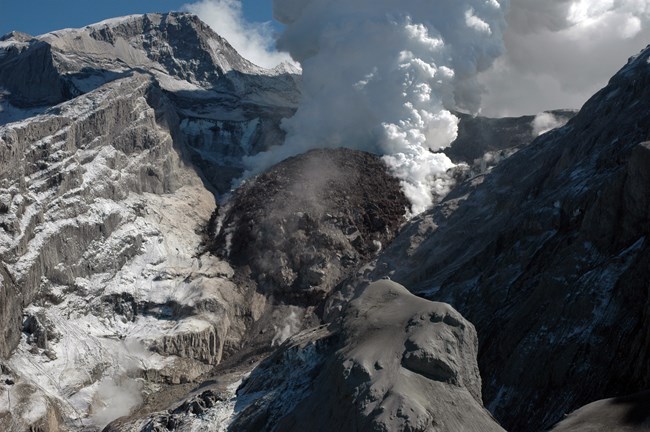
Lava domes often grow within summit craters and on the flanks of composite volcanoes. These domes are often made of silicic (dacitic to rhyolitic) lava. Sometimes magma is intruded within a composite volcano, but doesn’t erupt onto the surface. These shallow intrusions, known as cryptodomes, may cause a flank of a volcano to bulge.
Image (right): Dome growing in the summit crater of Redoubt Volcano in Lake Clark National Park in May 2009. Photo credit USGS Alaska Volcano Observatory
Lahars are volcanic mudflows. Lahars may occur during eruptions or be triggered by heavy rains, unusually rapid melting of snow or ice, or landslides. Lahars may be initiated by ash fall onto snow or glaciers, or by subglacial eruptions.
Pyroclastic flows are hot density currents of pumice, ash, blocks, and volcanic gas that rapidly move down the slopes of a volcano. They may be initiated by collapse of eruptive columns, by explosive eruptions that boil over, and by the collapse of lava domes. Pyroclastic flow deposits are important components of most composite volcanoes.
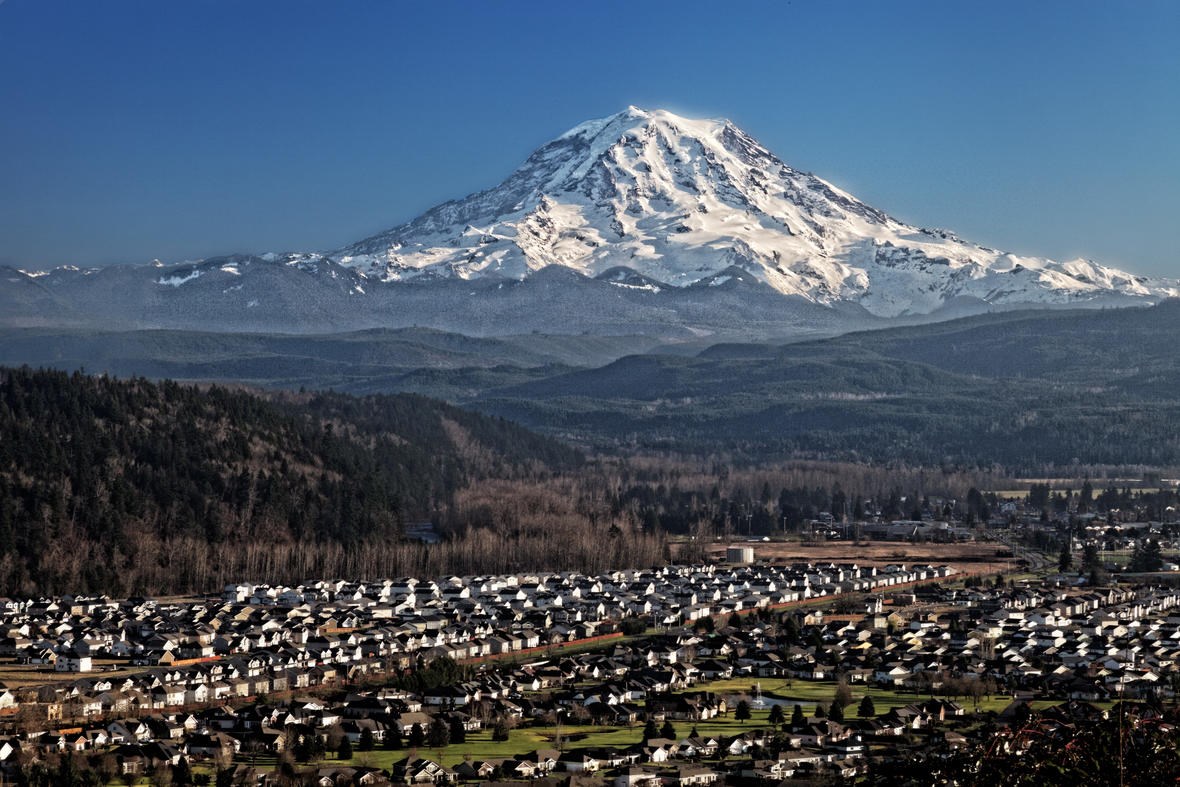
USGS photo by Ed Ruttledge.
A wide range of geohazards are present at composite volcanoes, both during eruptions and during periods of dormancy.
Mount Rainier is the most dangerous volcano in the continental United States because of its propensity for lahars and it is proximal to a large population center (the Seattle area).
Aniakchak National Monument (ANIA), Alaska—[ANIA Geodiversity Atlas] [ANIA Park Home] [ANIA npshistory.com]
Crater Lake National Park (CRLA), Oregon—[CRLA Geodiversity Atlas] [CRLA Park Home] [CRLA npshistory.com]
Katmai National Park (KATM), Alaska—[KATM Geodiversity Atlas] [KATM Park Home] [KATM npshistory.com]
Lake Clark National Park and Preserve (LACL), Alaska—[LACL Geodiversity Atlas] [LACL Park Home] [LACL npshistory.com]
Lassen Volcanic National Park (LAVO), California—[LAVO Geodiversity Atlas] [LAVO Park Home] [LAVO npshistory.com]
Mount Rainier National Park (MORA), Washington—[MORA Geodiversity Atlas] [MORA Park Home] [MORA npshistory.com]
Wrangell-St. Elias National Park and Preserve (WRST), Alaska—[WRST Geodiversity Atlas] [WRST Park Home] [WRST npshistory.com]
Yellowstone National Park (YELL), Wyoming—[YELL Geodiversity Atlas] [YELL Park Home] [YELL npshistory.com]
Part of a series of articles titled Volcano Types.
Previous: Cinder Cones
Next: Shield Volcanoes
Last updated: April 17, 2023